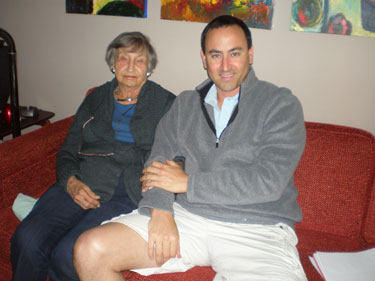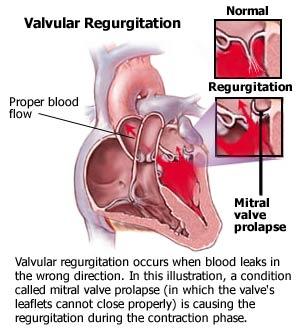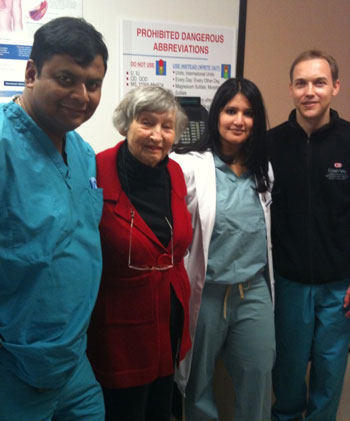Kato Pomer, 92, Has A New Lease On Life Thanks To… The MitraClip
By Adam Pick on June 3, 2010
At 92, Kato Pomer recently became one of the oldest, highest-risk patients to receive the MitraClip, a new minimally invasive treatment for severe mitral regurgitation, at Cedars-Sinai Medical Center.

Kato Pomer, 92, Mitral Valve Repair Patient
Recently, I was fortunate to meet and interview the psychiatrist, the teacher and the artist at her home in Los Angeles, California. Considering the widespread interest in the MitraClip and Kato’s unique story, I thought you might like to review the highlights of my interview with her.
Adam: Hi Kato. It’s wonderful to meet you. I must admit… I hope I look as good as you do if I make it to 92.
Kato: [Smiling] Thank you Adam for coming to see me.

Kato Pomer with Adam Pick
Adam: To start… I’m curious to know about your diagnosis. When were you diagnosed with severe mitral regurgitation?
Kato: In August 2009, I was on a walk while vacationing in Idyllwild, California when I started to experience shortness of breath. I was rushed to Eisenhower Medical Center in Rancho Mirage where I was officially diagnosed with mitral regurgitation and atrial fibrillation.
Adam: Had you experienced any cardiac problems in the past?
Kato: Yes, I had quadruple bypass about 12 years ago. But, my most recent echocardiogram, performed the previous February, showed no heart valve dysfunction.
Adam: Did I hear you right? In a span of 6 months, your mitral valve became severely diseased?
Kato: That’s correct. It was a very quick progression of mitral valve regurgitation. No one really knows why. I think it may have been partially triggered by the smoke I inhaled during my time in Idyllwild. There were many brush fires in California at that time.

Adam: Interesting… After you were diagnosed, I assume you were immediately entered into the MitraClip trial?
Kato: [She smiles and raises an eyebrow.] Unfortunately, it wasn’t that simple. First, a pacemaker was implanted to normalize my heart rhythm at Eisenhower.
As for surgically treating the mitral valve, my family was told that someone of my age was “high risk” with a potential 40% mortality rate during open heart surgery. Like many other high-risk patients, I was released from the hospital and went home under the care of my local cardiologist. At the time, I had no idea what the MitraClip was.
Adam: So how did you learn about the MitraClip?
Kato: My cardiologist, Dr. Stephen Berens, at St. John’s Hospital is excellent and keeps up with all the latest research. Upon learning of my situation, Dr. Berens mentioned the MitraClip to my daughter and suggested we contact Dr. Saibal Kar, the Director of Interventional Cardiac Research, at Cedars-Sinai Hospital in Los Angeles.
As Dr. Berens told my family, the MitraClip was my only hope. Without the MitraClip, my time was limited. There really was no alternative treatment option. I later learned that my daughter had already begun planning hospice care for me.
Adam: I did not know about this part of your journey. I’m sorry to hear it. What happened next?
Kato: Well… Getting into the MitraClip trials was not easy. There are very strict protocols and guidelines that must be followed. So, although I was admitted to Cedars-Sinai as a patient, I was not automatically accepted in the MitraClip study.
In fact, after an echocardiogram, Dr. Prediman K. (PK) Shah, the Director of Cardiology, who had been my late husband’s doctor, broke the news to me that I did not qualify to be part of the MitraClip trial. According to Dr. Shah, the echocardiogram showed that the MitraClip may not properly address the way in which the mitral leaflet was torn.
Adam: So how did you get admitted into the MitraClip study?
Kato: My daughter, Karen, was relentless. She contacted Dr. Berens, my original cardiologist, to update him on my situation. Doctor Berens suggested that a transesophageal echocardiogram (TEE) be repeated under general anesthesia (because it had proved too difficult for me to swallow the probe in previous attempts) as a last ditch effort to get additional information about the valve for Dr. Shah, Dr. Kar, Dr. Robert Siegel, the Director of the Cardiac Noninvasive Laboratory, and Dr. Alfredo Trento, the Director of Cardiothoracic Surgery, to evaluate.
Adam: One more test? How did you feel about the TEE?
Kato: Honestly, at that point, I wanted out of my misery. It had been about six weeks since my valve ruptured and I was ready to give up. But, my daughters would not let me go without a fight. They convinced me to have the one, final test that I dreaded the most. Even though I had to risk the potential complications of general anesthesia for the TEE, the results demonstrated that the MitraClip fix was appropriate.
Adam: How long (in weeks) did it take from your initial diagnosis to the MitraClip procedure?
Kato: In total, it took about 10 weeks. You should know that I also had several infections during this time which complicated the process and forced scheduling delays. During the course of those weeks, I relied heavily on Dr. Ramprasad Dandillaya, my Cedars’ cardiologist for the personalized, expert medical supervision I needed to keep going. Doctor Dandillaya consulted with my family on nearly a daily basis during the time I spent at home waiting for the MitraClip procedure.

Dr. Ramprasad Dandillaya and Kato Pomer
In order to be part of the MitraClip trials, the patient needs to be very stable with no infections or antibiotics for at least two weeks.
Adam: Can you tell me what it was like having the MitraClip implanted?
Kato: It was easier than having the TEE performed. According to the FDA protocol, I was admitted the day of the procedure. I left the hospital about 24 hours later.
It turns out that Dr. Saibal Kar, who has performed more MitraClip procedures than anyone else in the world, used two MitraClips to reduce the mitral regurgitation from severe to mild.

Dr. Saibal Kar, Kato Pomer, Asma Hussaini, PA and Dr. Bret Wertman
Adam: Did you experience any pain or discomfort during or after the MitraClip procedure?
Kato: No. Just a little soreness around the catheter incision site.
Adam: How are you doing today? Seven months after the procedure?
Kato: For me, I believe the MitraClip should be called the “MiracleClip”. As the people around me will attest, I was falling fast before this procedure. The other day, I was at the Santa Monica Farmer’s Market picking fresh fruits and vegetables. All in all, I’m very grateful for my supportive family and the incredible team of doctors who saved my life.
Adam: Thanks so much for taking the time to speak with me. Do you have any final words for those patients who may be considering this type of procedure in the future?
Kato: As for the MitraClip, I would simply tell future patients to “Go for it!”
And… As for you Adam, I want to thank you for your ongoing support of this community. Your heart valve book is a great contribution for anyone who has to undergo valvular treatment. I will recommend it to all of those in need.
I hope you enjoyed this interview about Kato Pomer and the MitraClip. In Part II of this story, you can come along for my observation of an actual MitraClip procedure being performed at Cedars-Sinai Medical Center.
Keep on tickin’ Kato!
Adam
|
Irene Harwood PhD says on June 3rd, 2010 at 1:23 pm |
|
Dearest Kato, I would love to visit you or to take you out, if you are up for it. a warm hug, |
 |
|
Ricky P.Laufer says on June 3rd, 2010 at 4:32 pm |
|
Ms Kato,I want to be like you when I ”grow up”. YOU ARE AMAZING.Thanks to you Adam.Ricky |
 |
|
Alita Letwin says on June 4th, 2010 at 1:43 pm |
|
A remarkable interview of a more remarkable woman! I know it is a cliche, but you ARE a role model of a person with great spirit and determination. Looking forward to seeing you with Karen. Fondly, Alita |
 |
|
Harry Brickman says on June 4th, 2010 at 9:01 pm |
|
Kato, Give my love and appreciation to Karen for her steadfast efforts to keep “our” Kato alive and well! Hope to see you soon again, Love, Harry |
 |
|
Sylvia Weishaus says on June 4th, 2010 at 11:25 pm |
|
Dear Kato: I had no idea you’ve been through such an ordeal, such a miraculous procedure! All the invitations to Idyllwild event — were you at the Wilderness event last week at your house? I do hope to see you at the event honoring Lora Steere. But there should be one honoring you! You are truly a hero and a model for us older people! Fondly, |
 |
|
Gladys says on June 5th, 2010 at 9:16 pm |
|
Hi Adam, |
 |
|
Karen Pomer says on June 12th, 2010 at 3:35 pm |
|
Dear Adam, Thank-you so very much for writing and publishing the story of my mother, Kato Pomer’s miraculous recovery from severe mitral-valve regurgitation on your wonderful blog. Our family hopes that in sharing this story we can help others. We will be forever grateful to my mother’s “A Team” at Cedars Sinai Medical Center: Dr. Saibal Kar, the Director of Interventional Cardiac Research, Dr. Prediman K. (PK) Shah, the Director of Cardiology, Dr. Robert Siegel, the Director of the Cardiac Noninvasive Laboratory, and Dr. Alfredo Trento, the Director of Cardiothoracic Surgery, for working so hard behind-the-scenes to help get my mother approved by the FDA and Evalve, for the Everest ll clinical trials, in order to have the life-saving MitraCilp (“MiracleClip”) procedure. Best, Karen Pomer |
 |
|
Joyce says on November 27th, 2013 at 5:55 am |
|
Hi – I was wondering who is the longest living person with the clip. I mean how long ago did they have it and are they still alive. My husband is due to have it done in the next few weeks and he is 45. how long has it been around for and the people that got it have they had it 4 or 5 years and still going strong |
 |













